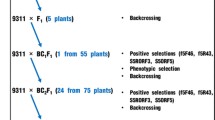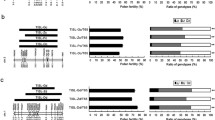Abstract
Though inter-subspecific hybrids from indica and japonica rice have gained great success for yield increases over the recent decade, there are severe sterility problems in such hybrids. To overcome hybrid sterility, we previously obtained the line PL-(S5-n + f5-n) in the genetic background of an elite indica restorer line 9311, via breeding strategy for construction of wide compatibility line, which was proven to be an effective strategy in improving the seed setting rate of indica-japonica hybrid rice. Here, a novel strategy for developing japonica-compatible indica lines was employed by introducing the japonica allele pf12-j into 9311. The obtained NIL-(pf12-j) could significantly improve pollen and embryo-sac fertility by 29.7% and 28.6% in indica-japonica hybrids, thus leading to 20.9% improvement of spikelet fertility. In addition, we achieved the pyramiding line PL-(S5-n + f5-n + pf12-j) by a combinational strategy using both wide compatibility line and japonica-compatible indica line. Compared to PL-(S5-n + f5-n) with 38.9% increase of spikelet fertility, the pyramiding line PL-(S5-n + f5-n + pf12-j) showed 49.7% increase of spikelet fertility, suggesting cumulative effect of wide compatibility alleles S5-n + f5-n and japonica allele pf12-j to shape normal fertility of inter-subspecies hybrid. Interestingly, these lines also showed compatibility to indica. Hence, our results demonstrate that the two strategies could be simultaneously applied for indica-japonica hybrid breeding, and S5-n + f5-n + pf12-j are the optional allelic combination for overcoming hybrid sterility. This finding will greatly enhance our understanding for breeding indica-japonica hybrid rice by molecular-assisted selection strategy.



Similar content being viewed by others
References
Chakraborty S (2001) Rice breeding and genetics. New Delhi, India
Chen L, Zhao Z, Liu X, Liu L, Jiang L, Liu S, Zhang W, Wang Y, Liu Y, Wan J (2011) Marker-assisted breeding of a photoperiod-sensitive male sterile japonica rice with high cross-compatibility with indica rice. Mol Breed 27:247–258
Chu YE, Morishima H, Oka HI (1969) Reproductive barriers distributed in cultivated rice species and their wild relatives. Jpn J Genetics 44:207–223
Guo J, Xu X, Li W, Zhu W, Zhu H, Liu Z, Luan X, Dai Z, Liu G, Zhang Z, Zeng R, Tang G, Fu X, Wang S, Zhang G (2016) Overcoming inter-subspecific hybrid sterility in rice by developing indica-compatible japonica lines. Sci Rep 6:26878–26878
Ikehashi H, Araki H (1984) Varietal screening of compatibility types revealed in F1 fertility of distant crosses in rice. Jpn J Breed 34:304–313
Ikehashi H, Araki H (1986) Genetics of F1 sterility in remote crosses of rice. In: IRRI (ed) Rice genetics. IRRI, Manila, pp 119–130
Khush GS (2005) What it will take to feed 5.0 billion rice consumers in 2030. Plant Mol Biol 59:1–6
Kubo T (2013) Genetic mechanisms of postzygotic reproductive isolation: an epistatic network in rice. Breed Sci 63:359–366
Kubo T, Yoshimura A, Kurata N (2011) Hybrid male sterility in rice is due to epistatic interactions with a pollen killer locus. Genetics 189:1083–1092
Kubo T, Yoshimura A, Kurata N (2017) Genetic characterization and fine mapping of S25, a hybrid male sterility gene, on rice chromosome 12. Genes Genet Syst 92:205–212
Li H, Durbin R (2009) Fast and accurate short read alignment with burrows-wheeler transform. Bioinformatics 25:1754–1760
Li H, Handsaker B, Wysoker A, Fennell T, Ruan J, Homer N, Marth G, Abecasis G, Durbin R, Genome Project Data Processing S (2009) The sequence alignment/map format and SAMtools. Bioinformatics 25:2078–2079
Li G, Li X, Wang Y, Mi J, Xing F, Zhang D, Dong Q, Li X, Xiao J, Zhang Q, Ouyang Y (2017) Three representative inter and intra-subspecific crosses reveal the genetic architecture of reproductive isolation in rice. Plant J 92:349–362
Lin J, Song X, Wu M (2012) Biological characteristics and heterosis utilization of four indica-japonica intermediate type restorer lines with wide compatibility. Chin J Rice Sci 26:656–662
Lu Y, Ma R, Wang X, Li X, Zhou H, Zhang Z, Hua G (2007) SSLP-based SSR fingerprinting and indica/japonica classification of Yongyou series hybrid rice (in Chinese with English abstract). Chin J Rice Sci 21:443–446
McKenna A, Hanna M, Banks E, Sivachenko A, Cibulskis K, Kernytsky A, Garimella K, Altshuler D, Gabriel S, Daly M, DePristo MA (2010) The genome analysis toolkit: a MapReduce framework for analyzing next-generation DNA sequencing data. Genome Res 20:1297–1303
Mi J, Li G, Huang J, Yu H, Zhou F, Zhang Q, Ouyang Y, Mou T (2016) Stacking S5-n and f5-n to overcome sterility in indica-japonica hybrid rice. Theor Appl Genet 129:563–575
Murray MG, Thompson WF (1980) Rapid isolation of high molecular weight plant DNA. Nucleic Acids Res 8:4321–4325
Ouyang Y (2016) Progress of indica-japonica hybrid sterility and wide-compatibility in rice. Chin Sci Bull 61:3833–3841
Ouyang Y, Chen J, Ding J, Zhang Q (2009) Advances in the understanding of inter-subspecific hybrid sterility and wide-compatibility in rice. Chin Sci Bull 54:2332–2341
Ouyang Y, Liu Y, Zhang Q (2010) Hybrid sterility in plant: stories from rice. Curr Opin Plant Biol 13:186–192
Qian Q, Guo L, Smith SM, Li J (2016) Breeding high-yield superior quality hybrid super rice by rational design. Natl Sci Rev 3:283–294
R Development Core Team (2018) R: A language and environment for statistical computing. R foundation for statistical computing, Vienna, Austria. Retrived from https://www.R-project.org/. Accessed 9/11/2019
Seck PA, Diagne A, Mohanty S, Wopereis MCS (2012) Crops that feed the world 7: Rice. Food Sec 4:7–24
Siddiq EA, Singh S (2005) Wide-compatibility system for yield enhancement of tropical rice through inter-subspecific hybridization. Advancesin Agronomy 87:157–209
Song X, Qiu S, Xu C, Li X, Zhang Q (2005) Genetic dissection of embryo sac fertility, pollen fertility, and their contributions to spikelet fertility of intersubspecific hybrids in rice. Theor Appl Genet 110:205–211
Wan J (2010) Utilization in heterosis of indica-japonca crosses (in Chinese). Proceed First Hybrid Rice Congress China 9:3–6
Wang J, Liu K, Xu C, Li X, Zhang Q (1998) The high level of wide-compatibility of variety ‘Dular’ has a complex genetic basis. Theor Appl Genet 97:407–412
Wang G, He Y, Xu C, Zhang Q (2006) Fine mapping of f5-Du, a gene conferring wide-compatibility for pollen fertility in inter-subspecific hybrids of rice (Oryza sativa L.). Theor Appl Genet 112:382–387
Yang Y, Wu J, Chen Z, Wang L, Guo H, Li J, Liu X, Lu Y (2009) Mining rice new germplasm containing S 5 n gene by functional molecular marker and sequencing. Chin Sci Bull 54:3258–3264
Yang J, Zhao X, Cheng K, Du H, Ouyang Y, Chen J, Qiu S, Huang J, Jiang Y, Jiang L, Ding J, Wang J, Xu C, Li X, Zhang Q (2012) A killer-protector system regulates both hybrid sterility and segregation distortion in rice. Science 337:1336–1340
Yu H, Xie W, Li J, Zhou F, Zhang Q (2014) A whole-genome SNP array (RICE6K) for genomic breeding in RICE. Plant Biotechnol J 12:28–37
Yuan L (1996) Hybrid rice breeding in China. In: Virmani SS, Siddiq EA, Muralidharan K (ed) Advances in hybrid Rice technology, proceedings of the third international symposium on hybrid Rice 26-33
Zeng Y, Hu C, Lu Y, Li J, Liu X (2007) Diversity of abnormal embryo sacs in indica/japonica hybrids in rice demonstrated by confocal microscopy of ovaries. Plant Breed 126:574–580
Zhang G, Lu Y (1999) Breeding of the Indica compatible Japonica lines and their use in the breeding of super high yield hybrid rice (in Chinese with English abstract). Hybrid Rice 14:3–5
Zhang Q, Zhou Z, Yang G, Xu C, Liu K, Saghai Maroof MA (1996) Molecular marker heterozygosity and hybrid performance in indica and japonica rice. Theor Appl Genet 93:1218–1224
Zhang H, Zhang C, Sun Z-Z, Yu W, Gu M, Liu Q, Li Y (2011) A major locus qS12, located in a duplicated segment of chromosome 12, causes spikelet sterility in an indica-japonica rice hybrid. Theor Appl Genet 123:1247–1256
Zhao M, Li X, Yang J, Xu C, Hu R, Liu D, Zhang Q (1999) Relationship between molecular marker heterozygosity and hybrid performance in intra- and inter-subspecific crosses of rice. Plant Breed 118:139–144
Zhu W, Li W, Ding X, Zhang Z, Zeng R, Zhu H, Zhang G (2008) Preliminary identification of F1 pollen sterility gene S-e in Oryza sativa. J S China Agric Univ 29:1–5
Acknowledgments
We are indebted to Dr. Lin Zhang from Yangzhou University for discussion.
Funding
This research was supported by grants from the National Key Research and Development Program of China (2016YFD0100803), the China Postdoctoral Science Foundation, and the Science and Technology Major Projects of Genetically Modified Organisms Breeding of China (High Yield Transgenic Rice Breeding, Grant No. 2016ZX08001004-001-007).
Author information
Authors and Affiliations
Contributions
J.M., Y.O., and T.M. conceived and designed the experiments; J.M. and Y.L. performed the experiments, including artificial crossing, genotyping, and selecting for breeding in the field; J.M. and G. P. analyzed the data; S. K., G. P., Y.O., and J.M. wrote the paper.
Corresponding author
Ethics declarations
Conflict of interest
The authors declare that they have no conflict of interest.
Additional information
Publisher’s note
Springer Nature remains neutral with regard to jurisdictional claims in published maps and institutional affiliations.
Electronic supplementary material
Fig. S1
Background selection using the array RICE6K in the generations BC2F1, BC2F3, and MF2. Numbers above the each chromosome indicate chromosome numbers. The blue and red lines indicate the heterozygous alleles of both the parents and homozygous alleles of donor parent, respectively. Gray lines indicate recipient parent alleles. The reference genome is based on MSU Rice Genome Annotation Project Release 6. (TIF 9270 kb)
Table S1
Primer sequence of InDel markers used for foreground and background selections (DOCX 22 kb)
Rights and permissions
About this article
Cite this article
Mi, J., Lei, Y., Kim, SR. et al. An effective strategy for fertility improvement of indica-japonica hybrid rice by pyramiding S5-n, f5-n, and pf12-j. Mol Breeding 39, 138 (2019). https://doi.org/10.1007/s11032-019-1044-x
Received:
Accepted:
Published:
DOI: https://doi.org/10.1007/s11032-019-1044-x




